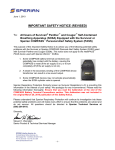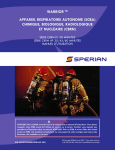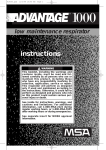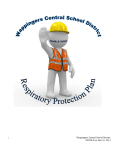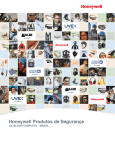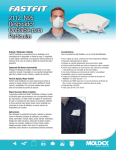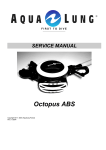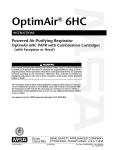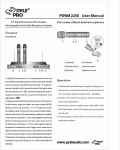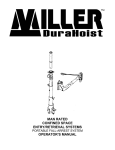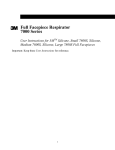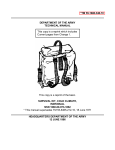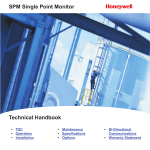Download Opti-Fit S-Series User Manual 1_08
Transcript
Opti-Fit™ Air Purifying Respirator Full Facepiece Operation and Maintenance Instruction Manual WARNING DO NOT USE this respirator until you completely read and understand this instruction manual. You are required to inspect the respirator prior to putting it into field service. Please refer to the inspection procedures in this manual. NIOSH APPROVED—SEE SEPARATE APPROVAL LABEL AN ISO 9001 REGISTERED COMPANY A Bacou-Dalloz Company 3001 South Susan St., Santa Ana, CA 92704 © Copyright SURVIVAIR March 2000 Toll-Free 888.APR.SCBA or 714.545.0410 All Rights Reserved Fax 714.850.0299 P/N 622094 Rev. E 01/2008 APR2/OPTIFIT2 www.survivair.com E-mail: [email protected] Table of Contents NIOSH CAUTIONS AND LIMITATIONS . . . . . . . . . . 3 I. INTRODUCTION . . . . . . . . . . . . . . . . . . . 3 II. SAFETY PRECAUTIONS . . . . . . . . . . . . . . . 3 III. DESCRIPTION. . . . . . . . . . . . . . . . . . . . 4 IV. PARTS LIST . . . . . . . . . . . . . . . . . . . . 7 V. HOW TO INSTALL CHEMICAL CARTRIDGES AND PARTICULATE FILTERS . . . . . . . . . . 11 A. Mercury Vapor Cartridges . . . . . . . . . . 11 B. Particulate Filters . . . . . . . . . . . . . . 11 C. Cartridge/Filter Installation . . . . . . . . . . 12 VI. HOW TO DON THE RESPIRATOR . . . . . . . . . . . 12 VII. HOW TO FIT CHECK THE RESPIRATOR . . . . . . . . 13 A. Positive Pressure Fit Check . . . . . . . . . . 13 B. Negative Pressure Fit Check. . . . . . . . . . 13 VIII. HOW TO USE THE RESPIRATOR . . . . . . . . . . . 14 IX. HOW TO DOFF THE RESPIRATOR. . . . . . . . . . . 14 X. CHEMICAL CARTRIDGE SERVICE LIFE AND REPLACEMENT . . . . . . . . . . . . . . 14 XI. PARTICULATE FILTER SERVICE LIFE AND REPLACEMENT . . . . . . . . . . . . . . 14 XII. MAINTENANCE . . . . . . . . . . . . . . . . . . 15 A. Inspection . . . . . . . . . . . . . . . . . 15 B. Cleaning . . . . . . . . . . . . . . . . . . 15 XIII. INSPECTION. . . . . . . . . . . . . . . . . . . . 16 XIV. REPAIR . . . . . . . . . . . . . . . . . . . . . . 17 XV. STORAGE . . . . . . . . . . . . . . . . . . . . . 17 XVI. SHIPMENT . . . . . . . . . . . . . . . . . . . . 17 XVII. OVERHAUL FREQUENCY . . . . . . . . . . . . . 17 XVIII. ADDITIONAL INFORMATION . . . . . . . . . . . 18 XIX. WARRANTY AND LIMITATION OF LIABILITY . . . . . 18 XX. INSPECTION TABLE . . . . . . . . . . . . . . . . 19 XXI. REPAIR TABLE . . . . . . . . . . . . . . . . . . 20 2 NIOSH APPROVAL CAUTIONS AND LIMITATIONS A - Not for use in atmospheres containing less than 19.5 percent oxygen. B - Not for use in atmospheres immediately dangerous to life or health. C - Do not exceed maximum use concentrations established by regulatory standards. H - Follow established cartridge and canister change schedules or observe ESLI to ensure that cartridges and canisters are replaced before breakthrough occurs. J - Failure to properly use and maintain this product could result in injury or death. L - Follow the User’s Instructions for changing cartridges, canisters and/or filters. M - All approved respirators shall be selected, fitted, used, and maintained in accordance with MSHA, OSHA, and other applicable regulations. N - Never substitute, modify, add, or omit parts. Use only exact replacement parts in the configuration as specified by the manufacturer. O - Refer to Users Instructions, and/or maintenance manuals for information on use and maintenance of these respirators. P - NIOSH does not evaluate respirators for use as surgical masks. S - Special or critical User’s Instructions and/or specific use limitations apply. Refer to User’s Instructions before donning. I. INTRODUCTION This manual provides instructions for the use and maintenance of the SURVIVAIR® Opti-Fit™ full facepiece air purifying respirator. This manual is applicable to Opti-Fit Models 7520, 7521, 7620, 7621, 7720, and 7721, which have threaded cartridge/filter connectors, and Models 7570, 7670, and 7770, which have bayonet cartridge/filter connectors. You must read and understand this manual and be trained in the proper use of the respirator before wearing it in a contaminated atmosphere. II. SAFETY PRECAUTIONS The Warnings, Cautions, and Notes contained in this manual have the following significance. WARNING Maintenance or operating procedures and techniques that may result in serious personal injury, serious illness, or death if not carefully followed. CAUTION Maintenance or operating procedures and techniques that may result in damage to equipment and/or minor to moderate personal injury if not carefully followed. 3 NOTE Maintenance or operating procedures and techniques or information considered important enough to emphasize. III. DESCRIPTION The SURVIVAIR Opti-Fit air purifying respirator consists of a full facepiece made of pliable silicone rubber with two connectors for attaching particulate filters, gas and vapor cartridges, and cartridge/filter combinations as required for specific contaminant protection. WARNING • The employer is responsible for establishing that this respirator is suitable for the user’s application. • SURVIVAIR cannot predict what will happen to this respirator in every potential environment. Materials can be chemically attacked if exposed to the wrong environment and may exhibit excessive corrosion or other forms of damage. Permeation or penetration of gases, liquids, or particles through the materials could be excessive. Extremes of temperature might cause thermal degradation. Each of these things, or a combination of them, could create conditions in which this SURVIVAIR respirator would be dangerous to use. • Before entering a hazardous environment while wearing this respirator, you must conduct safe, scientific tests to determine if the environment could render the equipment unsafe. Results of this testing should be well documented. Seek the help of a certified safety professional or industrial hygienist. DO NOT USE this equipment if the user would be endangered in any way through environmentally induced degradation of the materials in the apparatus. • All persons using this SURVIVAIR breathing apparatus must be made aware of its limitations. We cannot be responsible for any damage to property, personal injury, or death in which environmental exposure is a contributing factor. • Do not use this respirator in environments where the concentrations of contaminants are unknown or are immediately dangerous to life or health (IDLH). IDLH atmospheres are defined as: a. Those which the wearer could not breathe for short periods. b. Those from which the wearer could not escape without the aid of the respirator. c. Those which have an immediate or delayed adverse effect on health. • Do not use this respirator without the appropriate SURVIVAIR cartridges and/or filters securely attached onto the facepiece. Always read cartridge labels prior to use and be certain that you have cartridges and/or filters that will provide the required protection. This respirator must be used for protection against only those air contaminants listed on the air purifying cartridge, filter, and/or the NIOSH approval label. Respirators labeled for protection against particulates only shall not be used for gases/vapors. Respirators labeled for protection against gases/vapors only shall not be used for particulates. • Do not use this respirator at ambient temperatures above 130oF (55oC). • Do not use this respirator where environmental conditions could cause the respirator facepiece to be dislodged or slip. 4 WARNING—Continued • Immediately return to a non-contaminated area if: a. You taste or smell contaminants, or if your eyes, nose, or throat become irritated. b. Breathing becomes difficult. c. The air you are breathing becomes uncomfortably warm. d. You feel nauseous or dizzy. e. The facepiece moves, slips, or leaks. • This respirator does not protect exposed areas of the body. Some contaminants can be absorbed directly through the skin while others may irritate exposed areas. • This respirator does not provide protection from hazardous rays or harmful noise. Always wear proper head and ear protection. • This respirator does not supply oxygen and must not be used in atmospheres containing less than 19.5% oxygen by volume. • This respirator must not be used underwater, for fumigation, interior structural fire fighting, abrasive blasting operations, or in areas where high heat, sparks, or flames could contact the respirator. • This respirator must be used in conjunction with a written respirator program meeting the requirements of the OSHA Standard for Respiratory Protection, 29 CFR 1910.134, available from the U.S. Department of Labor, Occupational Safety and Health Administration. The program must include procedures for evaluating air contaminants and selecting appropriate respirators; procedures for proper use of respirators; procedures for testing the facepiece-to-face fit of respirators; procedures for cleaning, disinfecting, inspecting, maintaining, and storing respirators; procedures for determining if workers are physically and medically capable of wearing respirators; and procedures for training employees in the use and care of respirators and in recognizing the hazards associated with contaminants in the work place. • Do not wear this respirator if a satisfactory facepiece-to-face fit, as determined by a qualitative or quantitative fit test, cannot be obtained. See ANSI Z88.2, latest issue, and OSHA 29 CFR 1910.134, latest edition. Beards, stubble, or sideburns will prevent a good facepiece seal, and facial hair may interfere with valve function. Do not use this respirator unless you are clean shaven. Absence of one or both dentures can seriously affect the fit of the respirator. • This respirator will reduce, but will not eliminate the inhalation of contaminants. Some sensitive individuals may experience health problems when exposed to even minute amounts of contaminants. This respirator will not prevent health problems for those individuals. Where suspected cancer-causing contaminants are present, positive-pressure supplied-air respirators will provide higher protection levels. • Persons sensitized can have a severe reaction to chemicals at levels well below accepted health levels such as the OSHA Permissible Exposure Limit (PEL), ACGIH® Threshold Limit Value (TLV), or NIOSH Recommended Exposure Limits (REL). Do not use this respirator if you have been sensitized from previous exposure or believe that you may be sensitive or allergic to any chemical (e.g., isocyanates, latex, etc.) until you obtain clearance from a medical doctor. • Use of components other than those listed on the NIOSH approval label and in this manual, or as authorized by SURVIVAIR, or modification of this respirator in any manner will void the NIOSH certification and invalidates all SURVIVAIR's warranties for the respirator. • Always read and follow the instructions listed in the Material Safety Data Sheet for the chemicals that are present in the work area. • Do not use if you have a preexisting skin condition (for example, folliculitus or vitiligo) until you obtain clearance from a medical doctor. 5 WARNING—Continued • This respirator must be worn and used as specified in SURVIVAIR’s instructions. No respirator can provide complete protection from all conditions. Use extreme care for emergency conditions. • Some individuals are sensitive to chemicals (e.g., isocyanates, latex, oil mists, etc.) or may have some type of respiratory disorder (e.g. asthma, chronic obstructive airway disease, etc.). If you are sensitive to any chemical or have a respiratory disorder, you may have a severe reaction at contaminant levels well below accepted health levels, such as the OSHA Permissible Exposure Limit (PEL), ACGIH® Threshold Limit Value (TLV), or the NIOSH Recommended Exposure Limits (REL). Many chemicals (e.g., isocyanates, mercury, etc.) have no physical warning properties and you cannot taste or smell the contaminants even though they may be present in the respirator facepiece. This respirator will reduce, but will not eliminate the possibility of contaminants entering the facepiece and causing a severe reaction. Do not use this respirator until you obtain clearance from a medical doctor. • If this respirator will be used during welding, it is the user's responsibility to obtain the proper equipment for protection against sparks, optical radiation, and impact. This respirator will not protect you against these hazards. • Users must clean and maintain this respirator only in accordance with SURVIVAIR's instructions. Accessories not offered by SURVIVAIR may degrade performance, and will void NIOSH certification. • The respirator facepiece assembly contains natural rubber latex which may cause allergic reactions in some individuals. Discontinue use if you experience an allergic reaction. • Discontinue use if you experience skin irritation or discoloration. • This product may provide less than adequate protection if improperly used, which may result in serious personal injury, serious illness, or death. • For use by trained, qualified personnel only. • Routinely used respirators must be inspected before and after each use. Stored emergency respirators must be inspected after each use and at least once every 30 days. A written record must be kept of inspections of emergency respirators. • FAILURE TO OBSERVE ALL WARNINGS MAY RESULT IN SERIOUS PERSONAL INJURY, SERIOUS ILLNESS, OR DEATH. 6 IV. PARTS LIST (See Figures 1 and 2) ITEM 1a 1b 2 QTY 1 1 1 1 1 1 1 1 2 Pkg. of 6 P/N 702009 702089 962157 962167 962177 702007 962031 962037 839102 B140001 DESCRIPTION Headstrap, TPE Headnet, Mesh, Opti-Fit Small Skirt, Silicone Medium Skirt, Silicone Large Skirt, Silicone 3 Lens 4 Upper Rim 5 Lower Rim 6 Screw 7 Inhalation Valve Connector, 7000 Series (Incl. 2 Twin 8a Pkg. of 2 702036 Seals) 8b Pkg. of 2 702035 Connector, S-Series (Incl. 2 Twin Seals) 9 Pkg. of 2 702037 Twin Seal 10 Pkg. of 4 B140005 Exhalation Valve 11 1 820261 O-ring 12 1 702003 Nozzle 13 1 702004 Cover 14 2 962090 Valve Holder 15 1 702023 Nose Cup 16 2 702016 Short Buckle Strap, TPE 17 3 (0) 702012 Long Buckle Strap, TPE 18 5 (2) 702011 Buckle 19 5 (2) 702008 Ring 20 Pkg. of 2 780074 Filter Holder, 7000 Series 21 Pkg. of 2 B140074 Filter Holder, S-Series 22 1 780079 Filter Retainer, 7000 Series 23 1 140079 Filter Retainer, S-Series 24 1 910452 Christolube Lubricant 25 S-Series Cartridges—See Table 1 26 S-Series Filters—See Table 1 27 7000 Series Cartridges—See Table 2 28 7000 Series Filters—See Table 2 29 1 54140217 Strap, Mesh, Harness Note: Quantities in parentheses are for headnet configuration only. Optional Accessories 702019 Peel-away Lens Cover, Tinted (25) 702028 Peel-away Lens Cover, Clear (25) 962260 Spectacles Kit 951015 1 oz. Lens Anti-Fog Solution 951016 16 oz. Lens Anti-Fog Solution 981803 Wipe, Anti-Fog (Box of 100) 7 702031 Neckstrap Kit 702090 Headnet Kit Figure 1. Opti-Fit APR with Headstrap (S-Series Version) NOTE Use only components with the part numbers listed on the NIOSH approval label. Use of any other components will void the approval. 8 Figure 2. Opti-Fit APR with Headnet Table 1. Cartridges and Filters (S-Series) (See NIOSH Approval Label for Specific Contaminants) MODEL FILTERS 1050 P100 1060 Filter Pad, N95 1070 Filter Pad, N99/R95 1190 P100 Slimline MODEL CARTRIDGES 100100 Organic Vapors 100200 Acid Gases 100300 Organic Vapors and Acid Gases 9 100400 Ammonia and Methylamine 100600 Mercury Vapor and Chlorine 100800 Multi-contaminant 1051 Combination Organic Vapors and P100 1052 Combination Acid Gases and P100 1053 Combination Organic Vapors, Acid Gases, and P100 1054 Combination Ammonia, Methylamine, and P100 1056 Combination Mercury Vapor, Chlorine, and P100 1058 Combination Multi-contaminant and P100 Table 2. Cartridges and Filters (7000 Series) (See NIOSH Approval Label for Specific Contaminants) MODEL FILTERS 7860 Filter Pad, N95 7870 Filter Pad, N99/R95 7850 P100 7890 P100 Slimline MODEL CARTRIDGES 7801 Organic Vapors 7802 Acid Gases 7803 Organic Vapors and Acid Gases 7804 Ammonia and Methylamine 7808 Multi-contaminant 7851 Combination Organic Vapors and P100 7852 Combination Acid Gases and P100 7853 Combination Organic Vapors, Acid Gases, and P100 7854 Combination Ammonia, Methylamine, and P100 7858 Combination Multi-contaminant and P100 WARNING Following is a partial list of materials for which these respirators MUST NOT be used. This list is far from complete. Contact SURVIVAIR for information on other materials. The failure to comply with this warning may lead to serious personal injury, serious illness, or death. 10 Acroline Carbonyls Aniline Cyanogen Arsine Boron Hydrides Dimethylaniline Dimethyl Sulfate Bromine Ethyl Cyanide Carbon Dioxide Fluorine Carbon Monoxide Hydrogen Cyanide Hydrogen Selenide Isocyanates: TDI, HDI, MDI Methanol Methylene Chloride, Methyl Bromide, Methyl Chloride Nitro Compounds: Nitrogen Oxides Nitroglycerin Nitrobenzene Nitromethane Ozone Phosgene Phosphine Phosphorous Trichloride Stibine Sulfur Chloride Vinyl Chloride V. HOW TO INSTALL CHEMICAL CARTRIDGES AND PARTICULATE FILTERS A. Mercury Vapor Cartridges Special or Critical User's Instructions: The mercury vapor cartridges incorporate passive end-of-service-life indicators (ESLIs). Each ESLI, yellow in color when new, turns to gray when exposed to mercury vapor. Do not use these cartridges unless you can distinguish between the safe and discard colors of the ESLI. The indicators must be visible when wearing the respirator without having to manipulate either the facepiece or the indicator. If the indicator cannot be seen, do not wear the respirator. The cartridges must be replaced when the ESLIs change color from yellow to gray, when the ESLIs become dirty or damaged, after 30 days of use, or if removed from their original packaging and not used within 30 days. Never enter or remain in a hazardous atmosphere if one or more of the ESLIs is gray. B. Particulate Filters Before using a particulate filter, you must confirm the atmosphere is non-IDLH and not oxygen deficient, the contaminant is a particulate hazard, and you must determine the hazard ratio (hazard concentration/exposure limit). If the hazard ratio is less than 10, you may use a half mask respirator with a filter efficiency of 95% or higher. If the hazard ratio is less than 20, you may use a full facepiece respirator with a filter efficiency of 95% or higher. If the hazard ratio is less than 100, you may use a full facepiece respirator with a filter efficiency of 99% or higher. If the hazard ratio is greater than 100, you must use another type of respirator. N-series filters must only be used for non-oil containing aerosols or particulates. R or P-series filters can be used if the atmosphere contains oil (e.g., lubricants, cutting fluids, glycerin, etc.). An R-series filter used in an oil containing atmosphere must be replaced after each 8-hour work shift. A P-series filter can be used for more than one 8-hour work shift. Please refer to section XI, Particulate Filter Service Life, for important additional information. Refer to NIOSH Guide to the Selection and Use of Particulate Respirators Certified Under 42CFR84 for additional guidelines on use limitations for filters. 11 WARNING Filters improperly used or improperly assembled to the facepiece could cause leakage, which could lead to serious personal injury, serious illness, or death. C. Cartridge/Filter Installation 1. Ensure that you have the correct cartridge and/or filter type for the contaminants in your work area. If you are not sure, consult your supervisor or safety professional. 2. Install bayonet style cartridges or P100 filters by matching the alignment marks located on the cartridge or filter with the small lug or connector locking hook on the bayonet connector. Press the cartridge or filter into the facepiece and turn clockwise until it stops. Install threaded style cartridges or P100 filters by threading them onto the facepiece connectors and hand-tightening. Do not overtighten. 3. If using filter pads, insert the appropriate pad into the filter retainer so that the side stamped with the model number will face toward the facepiece when installed. Completely snap the filter retainers onto the cartridges or filter holders. 4. Inspect the filter through the retainer to ensure that the entire edge of the filter is making contact with the retainer and the filter is not bunched or folded. The outer edge of the pad must be compressed between the top edge of the cartridge or filter holder and the inner sealing rings of the retainer. Install filter holders in the same manner as cartridges. VI. HOW TO DON THE RESPIRATOR WARNING Always read cartridge labels prior to use to be certain that you have cartridges and/or filters that will provide the required protection. Filters labeled for protection against particulates only shall not be used for gases/vapors, and cartridges labeled for protection against gases/vapors only shall not be used for particulates. Both cartridges/filters must be of the same type. The failure to comply with this warning may lead to serious personal injury, serious illness, or death. OPTI-FIT FACEPIECE WITH HEADSTRAP: 1. Inspect the respirator as described in section XIII. 2. Adjust the top facepiece straps until one inch of strap extends through each buckle. Fully loosen the lower straps. 3. Place your chin against the chin cup and center the facepiece on your face. 4. Hold the facepiece against your face, and pull the straps over your head. 5. Tighten the two lower straps, the temple straps, then the top strap, until a good seal is obtained and all the headstraps lie flat on your head. Do not overtighten the straps. 12 NOTE When properly adjusted, the headstrap hub should be centered on the back of your head, and the lower straps should be below your ears. OPTI-FIT FACEPIECE WITH HEADNET: 1. Inspect the respirator as described in Section XII. 2. Fully loosen all straps. 3. Place your chin against the chin cup and center the facepiece on your face. 4. Hold the facepiece against your face, and pull the headnet over your head. 5. Tighten the two lower straps and the temple straps until a good seal is obtained and all the headstraps lie flat on your head. Flatten the headnet with a wiping motion toward the back of your head. Retighten the adjustment straps. Do not overtighten the straps. NOTE When properly adjusted, the lower straps should be below your ears. VII. HOW TO FIT CHECK THE RESPIRATOR You must perform the following fit check each time the respirator is worn or before entering the contaminated area. WARNING If a leak-tight seal is not obtained during the following fit check, do not wear the respirator. Ask your supervisor or safety professional for assistance. The failure to comply with this warning may lead to serious personal injury, serious illness, or death. You must perform the following fit check each time the respirator is worn or before entering a contaminated area. A. Positive Pressure Fit Check: Hold the palm of your hand gently over the exhalation valve outlet of the nozzle cover. Do not distort the natural shape of the facepiece. Exhale gently and hold your breath to create and maintain a slight positive pressure inside the facepiece. If air leakage occurs, readjust the facepiece and headstraps, then retest. B. Negative Pressure Fit Check: Cover the inlet of the cartridges and/or filters with the palms of your hands or another suitable item, such as a thin sheet of plastic or rubber. When the respirator is equipped with cartridges, filter retainers may be used as an aid. Alternatively, the cartridges may be removed to perform the fit check. If removed, SURVIVAIR recommends someone other than yourself reinstall them after a leak-tight fit is achieved. It is difficult for the wearer to reinstall the cartridges without disturbing the facepiece-to-face seal and to determine whether the cartridges are correctly seated against the facepiece. It is your responsibility to ensure that the facepiece-to-face seal is not disturbed when reinstalling the cartridges and that each cartridge is sealed against the facepiece. Inhale gently and hold your breath to slightly collapse the facepiece. If air leakage occurs, readjust the facepiece and headstraps, then retest. If filter retainers are used, do not remove them after the fit check is completed. Removing the filter retainers may shift the facepiece and break the facepiece-to-face seal. 13 VIII. HOW TO USE THE RESPIRATOR To receive the maximum protection available from your respirator, you must read, understand, and follow all the Warnings, limitations, and instructions contained in this manual and follow your employer’s instructions on the use and maintenance of the respirator. Read and understand the following warnings prior to using the respirator. WARNING • Never remove the respirator for any reason while you are in the work area. • You must leave the work area immediately if the facepiece-to-face seal is disturbed for any reason, such as: a. Slipping due to excessive sweating or excessive head movement. b. The facepiece becomes dislodged as a result of being knocked. c. You sneeze or cough while wearing the facepiece. d. You need to blow your nose, scratch covered areas of your face, or need to adjust your spectacles kit. e. For any other reason that would cause the facepiece seal to be disturbed. • You must restore the facepiece-to-face seal and perform a fit check in a non-hazardous environment before reentering the work area. • The failure to comply with this warning may lead to serious personal injury, serious illness, or death. IX. HOW TO DOFF THE RESPIRATOR A. Loosen all headstraps completely. B. Grasp the nozzle firmly, and pull the facepiece upward over the head. X. CHEMICAL CARTRIDGE SERVICE LIFE AND REPLACEMENT The cartridge service life depends on the user’s breathing rate, the characteristics of the contaminant, and environmental conditions such as temperature and humidity. Saturated cartridges leak trace amounts of contaminant to the wearer, which may be detected by odor, taste, and/or irritation. Replace cartridges daily, at the first trace of the characteristic contaminant odor or taste, at regularly scheduled intervals recommended by your safety professional, or if they show any signs of damage. Always replace cartridges in pairs. Replace cartridges as follows: A. Return to fresh air. B. Remove cartridges by turning counterclockwise. Dispose of used cartridges in accordance with Federal, state, and local guidelines. C. Install new cartridges, taken only from sealed packages, as described in section V.C. D. Perform a fit check as described in section VII. XI. PARTICULATE FILTER SERVICE LIFE AND REPLACEMENT The filter service life depends on the filter series type used, the user’s breathing rate, the characteristics of the contaminant, and environmental conditions such as humidity. All N and R-series filters should be replaced whenever they are damaged, soiled, contaminated with water, or causing increased breathing resistance. In addition, when an R-series filter is used in an oil containing atmosphere, the filter must be replaced after each 8-hour work shift. All 14 P-series filters must be replaced whenever they are damaged, soiled, contaminated with water, or as soon as they are too difficult to breathe through. SURVIVAIR recommends, due to considerations of hygiene, that all filters be replaced at least daily, and more often if necessary. Filters should also be replaced in accordance with schedules established by regulatory agencies. WARNING Failure to properly assemble filter pads to cartridges or filter holders can cause leakage, which could lead to serious personal injury, serious illness, or death. Replace filters as follows: A. Return to fresh air. B. If using P100 filters, remove by turning them counterclockwise. Dispose of used filters in accordance with Federal, state, and local guidelines. C. If using filter pads, remove the filter retainers from the cartridges or filter holders. Remove the used filter pads and dispose of them in accordance with Federal, state, and local guidelines. Clean the filter retainer and cartridge or holder if necessary. D. Install new P100 filters or filter pads (taken only from sealed packages) as described in section V.C. E. Perform a facepiece fit check as described in section VII. XII. MAINTENANCE A. Inspection Inspect this respirator as described in section XIII for defects before and after each use, and at least monthly if not used. Repair as necessary, clean and disinfect after each use, and store properly to assure that the respirator is maintained in satisfactory working condition. Keep a record of inspection and repair dates and results. B. Cleaning Respirators should be cleaned after each day's use by washing with mild soap and warm water. Then disinfect the respirators with a suitable sanitizing solution. OSHA 1910.134, latest edition, and ANSI Z88.2, latest edition, also provide information and guidelines on the cleaning and sanitizing of respirators. WARNING • Specialized processes are required to disinfect and decontaminate a respirator. You must follow the instructions of the manufacturer of the equipment and chemicals. • It is the user’s responsibility to ensure that the processes chosen provide adequate cleaning, disinfection, and decontamination, and do not damage the respirator in any way. • In the absence of a commercial sanitizing product, the hypochlorite solution described below will eliminate many, but not all biohazards. • The failure to comply with this warning may lead to serious personal injury, serious illness, or death. 15 CAUTION Do not use solvent type cleaners to clean any part of the respirator. NOTE Silicone and rubber parts of the facepiece may be cleaned between washings with SURVIVAIR Mask Wipes, P/N 140096 or 140082. 1. Make a cleaning solution of warm water and a mild detergent. 2. Remove the cartridges/filters from the facepiece. 3. Immerse the facepiece top first in the solution until the exhalation valve is covered. 4. Agitate the facepiece and gently clean with a soft brush. 5. Thoroughly rinse the facepiece in fresh water, paying particular attention to removal of all soap residue from the exhalation valve. If possible, direct running water onto the exhalation valve. 6. Disinfect the facepiece in a warm (120°F or 48°C maximum) suitable sanitizing solution such as a 'hypochlorite solution" for 2 to 3 minutes. A 50 ppm hypochlorite solution can be made by mixing 0.13 ounce of laundry bleach per each gallon of water. Rinse thoroughly with fresh warm (120°F or 48°C maximum) water. 7. Allow the facepiece to drip dry, or dry with a lint-free cloth. Warm air may be used to speed up drying. NOTE Washing the lens will remove any user-applied anti-fog coating. Recoat with SURVIVAIR Anti-fog solution, P/N 951015 (1 oz.), or 951016 (16 oz.), or use SURVIVAIR single-use anti-fog wipes, P/N 981803. 8. After cleaning, apply three drops of anti-fog solution as required to the inner surface of the lens and spread with your finger. Buff with a lint-free cloth. If using an anti-fog wipe, follow the instructions on the wipe packet. 9. Hold the facepiece firmly against your face and exhale several times to ensure that the exhalation valve functions smoothly. 10. Carefully inspect the respirator as described in section XIII. Reinstall the cartridges and/or filters before use. XIII. INSPECTION (See the Inspection Table) Inspect the respirator before and after each use as described in the inspection table and replace any damaged component. See section XIV for repair instructions. WARNING • Do not use the respirator with damaged or improperly operating valves. • Ensure that the twin seal is in the o-ring groove between the lens and connector. Ensure that the part number tab on the o-ring is visible and in the notch provided on the lens. Ensure that the nozzle o-ring is on the nozzle and the nozzle is snapped into the lens. 16 WARNING¾Continued • The failure to comply with this warning may lead to serious personal injury, serious illness, or death. XIV. REPAIR (See the Repair Table) Repair by the user is limited to replacement of components listed in this manual and as listed on the NIOSH approval label. Disassembly should be performed only to the extent necessary to replace the components. To protect your warranty and the NIOSH certification of the equipment, all other repairs must be done only by authorized SURVIVAIR technicians and repair centers. Consult your SURVIVAIR distributor for the one nearest you. You must perform a fit check as described in section VII after any repair and before respirator use. XV. STORAGE After inspection and cleaning, store your SURVIVAIR Opti-Fit facepiece to protect it against dust, sunlight, extreme heat and cold, excessive moisture, or damaging chemicals. WARNING • This SURVIVAIR respirator does not have a defined storage life. Carefully inspect it before each use. • The failure to comply with this warning may lead to serious personal injury, serious illness, or death. CAUTION The maximum storage temperature for this device is 140°F (60°C). Long term exposure to elevated storage temperatures could cause premature deterioration. XVI. SHIPMENT All products returned to SURVIVAIR's factory, distributors, or repair centers must be decontaminated prior to shipment. XVII. OVERHAUL FREQUENCY This SURVIVAIR respirator does not have an overhaul requirement other than that required in section XII, Maintenance. 17 XVIII. ADDITIONAL INFORMATION If you need assistance or additional information on any SURVIVAIR product, consult your local distributor or contact: SURVIVAIR A Bacou-Dalloz Company 3001 S. Susan Street Santa Ana, CA 92704 U.S.A. (714) 545-0410 or (FAX) (800) 201-4407 Email: [email protected] ALL RETURNED PRODUCTS MUST BE DECONTAMINATED PRIOR TO SHIPMENT. PRODUCTS CONTAMINATED WITH DANGEROUS SUBSTANCES WILL BE REFUSED AND RETURNED FREIGHT COLLECT. XIX. WARRANTY AND LIMITATION OF LIABILITY LIMITED WARRANTY: SURVIVAIR® warrants this product to be free from defects in materials and workmanship for 5 years (for the skirt) and 1 year (for all other components) from the date of purchase. During this period, SURVIVAIR will repair or replace defective parts, at SURVIVAIR’s option. Freight charges to and from the SURVIVAIR factory shall be paid by the purchaser. EXCLUSIONS: NOTWITHSTANDING ANY CONTRARY TERM IN THE PURCHASER’S PURCHASE ORDER OR OTHERWISE, THE ONLY WARRANTY EXTENDED BY SURVIVAIR IS THE EXPRESSED LIMITED WARRANTY DEFINED ABOVE. THIS WARRANTY IS EXCLUSIVE AND IN LIEU OF ANY IMPLIED WARRANTY OF MERCHANTABILITY, OR FITNESS FOR A PARTICULAR PURPOSE. CONDITIONS: To maintain this warranty this product must be used, maintained, and inspected as prescribed in the owner’s instruction manual, including prompt replacement or repair of defective parts and such other necessary maintenance and repair as may be required. Normal wear and tear; parts damaged by abuse, misuse, negligence, or accidents; and inhalation and exhalation valves and twin seals are specifically excluded from this warranty. LIMITATION OF LIABILITY: No other oral warranties, representations, or guarantees of any kind have been made by SURVIVAIR, its distributors, or the agents of either of them, that in any way alter the terms of this warranty. EXCEPT AS HEREIN PROVIDED, SURVIVAIR SHALL HAVE NO LIABILITY FOR ANY LOSS OR DAMAGE, WHETHER DIRECT, INDIRECT, INCIDENTAL, OR CONSEQUENTIAL, TO ANY PURCHASER OR USER OF THIS PRODUCT ARISING FROM THE SALE, USE, OR OPERATION OF THIS PRODUCT. WARNING The failure to use and maintain this equipment in strict conformance with the applicable instruction manual may result in serious personal injury, serious illness, or death. The equipment's use in any manner that is not expressly authorized pursuant to the applicable instruction manual may result in severe adverse impacts to human health. 18 XX. INSPECTION TABLE IF ANY OF THE DEFECTS LISTED BELOW ARE FOUND, HAVE THE RESPIRATOR REPAIRED BEFORE USE. COMPONENT LOOK FOR FACEPIECE LENS 1. Nicks, scratches, or abrasions which could impair visibility. 2. Deep gouges or cracks which could reduce impact resistance. 3. Anti-fog coating in need of replacement. FACEPIECE RIMS 1. Deformed, cracked, or broken. 2. Loose screws. Do not overtighten. FACEPIECE SKIRT 1. Cuts, gouges, or punctures. 2. Tears or nicks in the sealing area. 3. Deterioration from age, heat, or contamination. FACEPIECE HEADSTRAPS AND BUCKLE STRAPS 1. Abrasions or nicks. 2. Deterioration from age, heat, or contamination. FACEPIECE BUCKLES Crushed, bent, broken, or corroded. FACEPIECE INLET NOZZLE 1. Heat or impact damage. 2. Nicks, cracks, tears, or creases in the exhalation valve. Remove the valve cover from the nozzle to inspect it. 3. Nicks, cracks, or dents in the exhalation valve seat. 4. Sticking exhalation valve. Exhale a few times to test. The valve must close after each exhalation. Valves that fail to close must be replaced. O-RINGS/TWIN SEALS Cuts, nicks, abrasions, or excess stretching. CARTRIDGE CONNECTORS 1. Cracks, heat, or impact damage. 2. Cuts, nicks, or abrasions on connector sealing flange. HEADNET 1. Signs of deterioration, weakening, and wear in the headnet and straps. 2. Unraveled or loose stitching. 19 XXI. REPAIR TABLE COMPONENT INSTRUCTIONS HEADSTRAP/HEADNET REPLACEMENT 1. Remove the old headstrap/headnet from the facepiece, noting the routing of the straps. 2. Install new headstrap/headnet. TWIN SEAL/CONNECTOR REPLACEMENT 1. To remove, rotate the connector clockwise. Lift the connector hook and rotate the connector counterclockwise, and pull outward. 2. Remove twin seal o-ring from groove in lens. 3. To install, gently separate the o-ring and gasket halves of the new twin seal. A small part number tab should remain attached to each half. Do not use the o-ring if it is damaged. 4. Place the o-ring into the groove on the lens with the part number tab aligned with the slot. 5. Align the three lugs on the underside of the connector with the three slots in the lens. Insert the connector into the lens port and rotate clockwise. An audible click should be heard. 6. Install the new gasket onto the connector. The gasket must be seated in the groove in the connector. NOZZLE COVER REPLACEMENT 1. To remove, pinch the two lower latches while lifting the lower tab. 2. Disengage the upper hook by lifting the cover upward. 3. To install, engage the cover on the nozzle upper hook. 4. Rotate cover downward until both lower latches engage the cover. An audible click should be heard. 20 XXI. REPAIR TABLE (Continued) COMPONENT INSTRUCTIONS LENS REPLACEMENT 1. Remove any cartridges and/or filters from the connectors. 2. Use a 5/32 inch Allen wrench to remove the two rim screws. 3. Gently separate the rims from the facepiece. 4. Pull the silicone skirt away from the lens. 5. Remove the nozzle cover as described above. 6. Remove the nozzle as described above. 7. Remove the connectors and twin seals as described above. 8. Install new twin seals and connectors into the new lens as described above. 9. Replace the nozzle o-ring and inspect the exhalation valve. 10. Install the nozzle and cover as described above. 11. Place the lens edge inside the lens channel of the skirt. 12. Knead the skirt until the silicone fits evenly around the lens edge. 13. Install the rims. Start the screw on one side, then the other. CAUTION—Do not pinch the silicone between the rims. 14. Alternate tightening each screw until firmly tightened. Do not overtighten. 15. Perform a facepiece fit check as described in section VII. EXHALATION VALVE 1. Remove the nozzle cover as described above. 2. Remove and discard the old exhalation valve. 3. Insert a new valve and pull the valve stem until it snaps into place. 4. Replace the nozzle cover as described above. 5. Perform a facepiece fit check as described in section VII. ACCESSORIES Each modification kit and accessory purchased from SURVIVAIR has installation instructions. Use these instructions for removing and replacing any accessory. 21 22 23 www.bacou-dalloz.com


























